These highlights chronicle the year 2020. The year runs generally
"backwards" on this page.
The abbreviation "MTY" means "Monterey County"
in the text below. Text by Don Roberson. Photos on this page
are copyrighted by the photographers to whom they are
attributed, and may not be reproduced in any form (including
other web sites) without the express consent of the photographer. |
| |
 From mid-August into fall, MTY was devastated by three huge wildfires that together burned more than 240,000 acres in the center of the county. Each of the fires began between 16-18 August, and some of the merged: the 48,000 acre River Fire (photo © Crystal Hamer, left), the 69,000 acre Carmel Fire, and the 124,000 acre Dolan Fire in the Ventana Wilderness (it was contained but not yet out into December). Access to many areas was closed — sometimes for months — and the Ventana Wilderness Society lost its Condor release facilities. Three California Condors disappeared but a younster in a nest, thought also to have been lost, survived. From mid-August into fall, MTY was devastated by three huge wildfires that together burned more than 240,000 acres in the center of the county. Each of the fires began between 16-18 August, and some of the merged: the 48,000 acre River Fire (photo © Crystal Hamer, left), the 69,000 acre Carmel Fire, and the 124,000 acre Dolan Fire in the Ventana Wilderness (it was contained but not yet out into December). Access to many areas was closed — sometimes for months — and the Ventana Wilderness Society lost its Condor release facilities. Three California Condors disappeared but a younster in a nest, thought also to have been lost, survived.
On 10 August, before any of the fires started, Brian Sullivan discovered this young Neotropical Cormorant at the pond at Rancho Cañada, now part of Palo Corona Regional Park (photo © B.L. Sullivan). This is the 3rd for the county — and Brian found all 3 of them! Alas, none have been chaseable. Local dog-walkers advised arriving birders at Rancho Cañada that the cormorant had flown off to the west. It was never refound. |
 |
A number of unexpected avian occurrences helped enliven a Covid-sheltered July 2020. On 22 July, Kent Van Vuren discovered a Gray Catbird in Locke-Paddon Park, Marina, that remained into August (photo below left, 22 July, © K. Van Vuren). As befits most Gray Catbirds, it was much easier to hear than to see, let alone photograph. This is the 11th record for MTY but 5 previous records have been in June-July. These were generally considered to be late migrants, and none had been discovered so late in summer. We now treat this as our first summering Catbird.
An interesting White-crowned Sparrow in summer could easily go overlooked. Our local breeding and resident race is nuttalli. In MTY south of Elkhorn Slough, "Nuttall's" White-crowned breeds almost entirely in sand dunes west of Hwy 1, with a few breeding just east of Hwy 1 in Marina and again from Mal Paso Canyon to Garrapata SP. The few dispersant "Nuttall's" east of the sand dunes in summer are typically in juvenal plumage. Thus this fully adult White-crowned Sparrow east of Hwy 1, in the High Meadows Open Space of Carmel on 16 July, was of note (below right, 16 July, © Michael Rieser). The adult is in wing and tail molt so it is "summering" at this location. Its primary projection, back pattern, relatively unmarked bill, comparatively 'pure gray' breast and neck, and fully-black head stripes all the way to the nape support the identification as the pugetensis subspecies of White-crowned Sparrow [see photo essay on this site on the three subspecies that reach MTY]. Race pugetensis ["Puget Sound" White-crowned Sparrow] breeds from northwestern California to southern British Columbia, and migrates here to winter between September and April. It is very common along our coast in those months, filling in all appropriate coastal habits east of the shoreline sand dunes. The entire wintering population is gone in summer. In fact, there is only summer record for MTY: 17–27 July 1957, a tail-less individual at Hastings NHR in upper Carmel Valley (John Davis; see Roberson 2002). We might speculate that this year's High Meadows bird also lost part of its tail (to a cat attack?) and was thereby precluded from migrating north. If so, it remained to molt in its full tail, and undergo wing molt as well. |
|
The last two summers have provided new information about perhaps our most elusive breeding bird* in Monterey County: Hermit Thrush. Our Breeding Bird Atlas project (1988-1992) obtained "probable" or "possible" breeding evidence in only seven 5x5km atlas blocks, all in redwood canyons along the Big Sur coast (map at right). As expressed by Joseph Grinnell in 1902, when he searched for our local breeding race: "in the deepest parts of the woods was the Monterey hermit thrush, a bird which we found more elusive the more we sought after it!" Monterey is the type locale of the subspecies slevini, a small gray race nesting from coastal Washington to central California. Today we know that MTY's breeders are the southernmost population of slevini, a bird that is much more common in the Santa Cruz Mountains. Recent studies suggests it may winter only in Baja California.
During our Atlas, the tiny MTY population was centered in the redwood and Douglas-fir canyons of the Big Sur and Little Sur watersheds.
* = Flammulated Owl & Mountain Chickadee would be in the running for that title but none have been found since 2007 and 2015, respectively, and perhaps MTY populations of both were extirpated during the huge fires of 2008 (Basin Complex) or 2016 (Soberanes)? Ephemeral marginal breeders (e.g., Eared Grebe, Redhead, Golden-crowned Kinglet) were not considered.
|
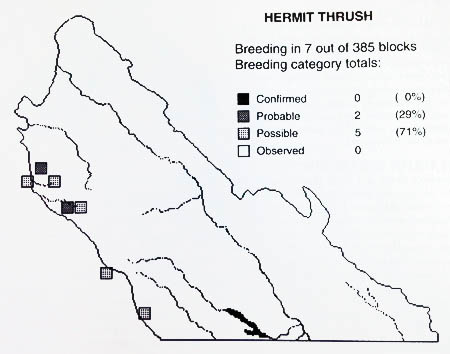 |
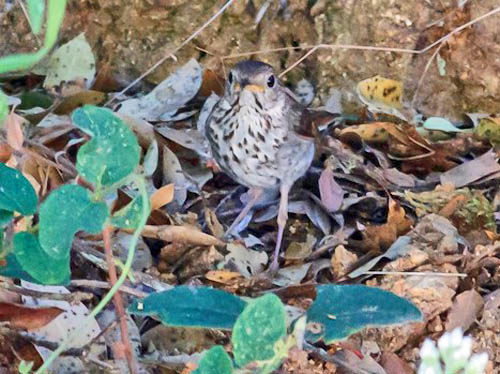 |
In July 2019, Michael Rieser tape-recorded a singing Hermit Thrush in Williams Canyon, near San Jose Creek, the northernmost slevini to be documented on territory in the Santa Lucia Mts of MTY (recording in eBird). In late June 2020, Steve Rovell & the Roses found another singing Hermit Thrush along Rocky Creek — the next creek south of Palo Colorado Canyon — later Carole & Larry Rose obtained a tape and photos (left on 23 June, © Carole Rose). In July 2020, Don Roberson & Rita Carratello found counter-singing males along upper Bixby Creek, and Michael Rieser had a singing male at the confluence of Bixby and Sierra creeks, lower down Bixby Canyon (recordings from both sites in eBird).
These Hermit Thrushes were on territory along different creeks than were known during the Breeding Bird Atlas, so all add pieces to the puzzle of locally nesting Hermit Thrushes.
Of course, large numbers of migrant Hermit Thrushes arrive in Oct-Nov each fall and many remain to winter locally. We believe all these wintering birds are from other subspecies that breed far to north. There is no evidence that any slevini winters anywhere but Mexico.
|
|
|
Some spectacular red birds brightened our Covid-19 summer: one occupies a panel below, and the others were first-summer male Summer Tanagers (including a first-summer male in varying stages of body molt). From late June and into July, these one-year-old birds were at such unusual spots at lower Palo Colorado Canyon (in eucs; Steve Rovell & the Roses), heard in the Carmel Highlands (Michael Rieser), and one in Veterans Memorial Park, upslope in the City of Monterey. The latter red-yellow-and-orange male was first discovered on 28 June (Shane DeFreeuw) and still present into August (photo above left, on 20 July, © Carole Rose; above right, 30 July © Terence Degan).
Although MTY has a few migrant and wintering Summer Tanagers each year (including one that completed his 7th winter here this spring), summer records are few indeed. Excluding records for early June (late spring migrants) and late August (early fall migrants), the only prior summer records before the 3 this summer are these: three in our Pacific Grove yard (one in July 1985, two on 21 June 2008; D. Roberson, R. Carratello); one banded at Big Sur R. mouth and present 28 June-2 July 2004 (Rob Fowler); and a male at the Frog Pond Preserve, Del Rey Oaks, 15 July 2014 (Virginia Chomat). |
The most excitement in early July was provided by the return of the adult male Vermilion Flycatcher to Rancho Cañada on 2 July [Rancho Cañada is now incorporated into the larger Palo Corona Regional Park]. This appears to be the same male present at this site last summer. Its behavior and its territory are the same — centered around a fenceline and a stand of dead pines that separates Palo Corona from private property that is slated for future development. Karen Kreiger discovered this beauty last summer on 17 June, and photographed its return on 2 July (right, © Karen Kreiger). Flight shots are below (below left 3 July, © Bill Hill; below right 2 July, © D. Roberson).
Last year's Vermilion was present 17-25 June 2019. The fully verified dates of this year's occurrence are 2 July–1 Sep.
There are now 13 records for MTY (this individual represented record #12 last summer, and is considered a returning individual, so not an extra record. Vermilion #13 was last Oct at Big Sur R. mouth). There is an excellent record of verifying MTY Vermilions by photos; 11 of our 13 records have photos. |
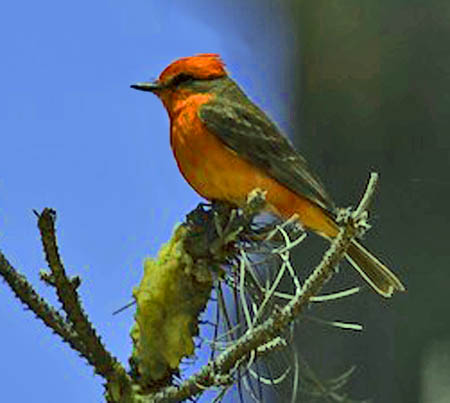 |
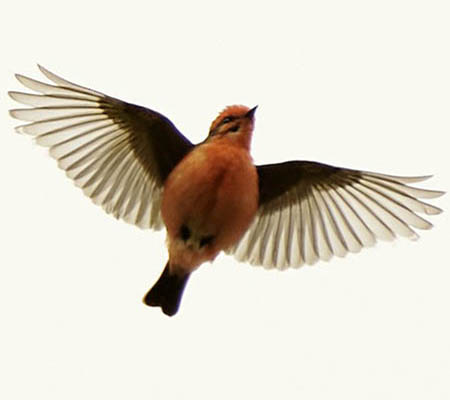 |
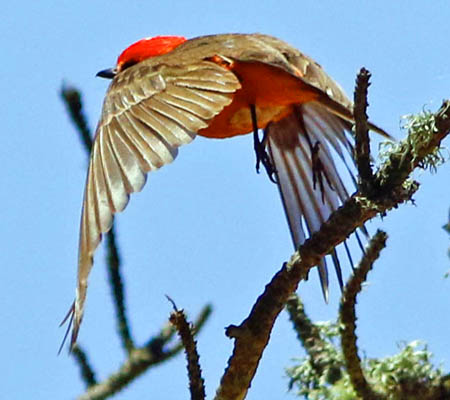 |
|
In recent years, our summer reports have included the first MTY breeding of Redhead and Eared Grebe (both in summer 2017). In addition, there have been recent breeding range extensions for Peregrine Falcon, Western Kingbird, and Blue Grosbeak (farther down this page). Now we can add yet another nesting species to the list of county breeders: California Gull.
Readers may recall the first successful nests of Heermann's Gull in the entire United States, at Roberts Lake, Seaside, back in summer 1999; see Roberson et al. (2001) for more details. Heermann's continued to nest there until the breeding islets washed away (about 2006) but a small colony moved to nest on nearby rooftops by 2013. Those colonies continued to breed but have been threatened by the netting that excludes access to some rooftops, a fire that destroyed another nesting location, and distance from water. In 2019, Monterey Audubon sponsored the anchoring of a raft on Roberts Lake in an attempt to restart a colony at this safer location. Although some Heermann's checked out the location in 2020, none have yet nested there. In the meantime, both the raft and rooftops are monitored by a quiet drone. These drone surveys of Heermann's nests discovered nests of California Gulls in two Monterey County coastal cities by 22 May 2020, and hatched young in one colony by 12 June. One of the rooftop colonies is also used for nesting by Heermann's Gull [photo below 12 June, © Byron Chin, showing 4 active California Gull nests and a couple active Heermann's nest (upper right)]. Together the two California Gull colonies have about 178 nests, so this is already a substantial population. Since the drone checked these rooftops last year and did not find breeding California Gulls, this appears to be the first breeding ever for this species in Monterey County.
California Gulls are famed for their large colonies at Mono Lake, east of the Sierra Nevada range, which were once threatened by the diversion of Mono Lake water to Los Angeles back in the 1960s-1980s and eventually led to a major environmental victory in the California Supreme Court that saved Mono Lake. [Obviously the species also has famous colonies at Great Salt Lake, Utah, and are credited with saving the first Mormon farmers there.] California Gull breeding range expanded to salt ponds around south San Francisco Bay in 1980 (Bausman 2007). Surveys by San Francisco Bay Bird Observatory revealed that from fewer than 50 breeding birds in the early 1980s, the breeding population had expanded to over 50,000 breeding gulls there in 2014. With such an expanding breeding population in San Francisco Bay, it is not a big surprise that the species is now nesting here as well. |
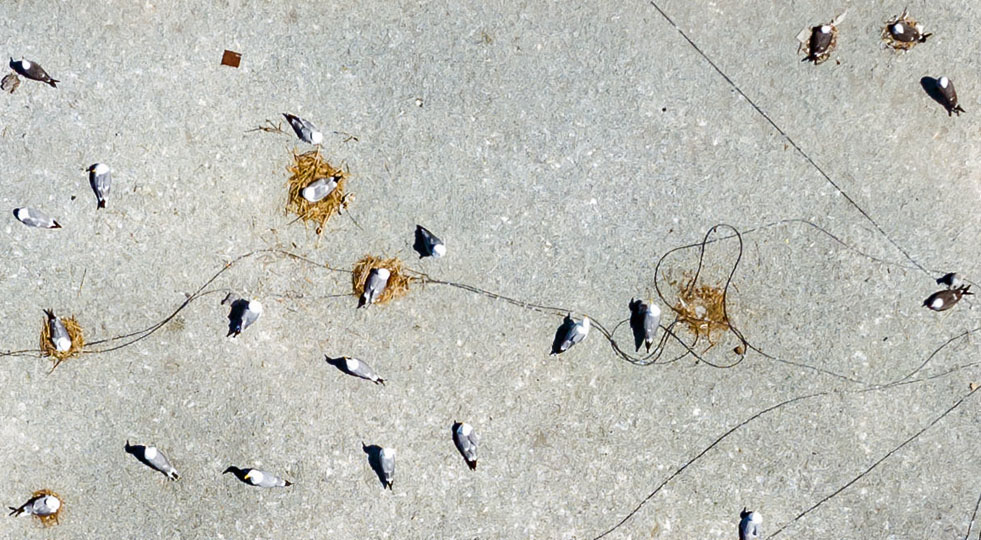 |
|
| It is also just a matter of time until we add Cedar Waxwing to the list of MTY's breeding birds. There has now been a series of breeding activity by waxwings on the Santa Cruz County side of the Pajaro River, including two nests at the Pajaro Dunes in 2016 (eggs hatched in one nest but fledgling may been predated), a juv at CARE park near Watsonville in 2018, two active nests at that site in 2019, both with fledglings, and a nest there in 2020. There is already some suggestive evidence of MTY breeding (summarized in Roberson 2002) but nothing fully confirmed. This year 3 waxwings were along the Carmel River on 2 July (one of them photo'd, right, © John J. Hiles) and up to 7 were still present on 15 July (D. Roberson, B.L. Sullivan). These dates surpass the latest spring occurrences for the county (excluded the movements of the Pajaro River breeders mentioned above), and suggest local breeding. Waxwings sometimes return in fall as early as mid-August; one in upper Carmel Valley on 30 July 2015 (B.L. Sullivan) might have been our earliest migrant or, possibly, a failed breeder. Local observers should be watching for confirming evidence of nesting along riparian corridors in MTY . |
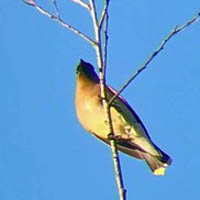 |
In shorebirds, fall migration begins during the last week of June. An adult Pacific Golden-Plover in alternate (=breeding) plumage on 27 June at Zmudowski SB pond was our earliest wader rarity (Brian L. Sullivan & Paul Fenwick; photo right, © P. Fenwick).
The Covid-19 pandemic and "shelter in place" orders have been a good reason to focus on interesting birds at local eBird Hot Spots. This summer brought two first records for the Laguna Grande hot spot in Seaside: a group of three Black-necked Stilt on 29 May, found by Steve Rovell (photo of one, below left, © Rita Carratello), and then two American Avocet on 30 June, found by Paul Fenwick (photo below right, © P. Fenwick). Both are quite rare anywhere on the Monterey Peninsula although both species breed widely around Elkhorn Slough. |
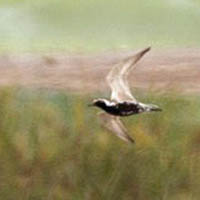 |
|
|
. . . . This earlier update (about the birds shown below) was written on the 3rd Sunday of June 2020, when I noted that "It feels like there have been a lot more birds of note in the last 3 weeks than the 4 months that preceded June 2020. Ergo, an update." By far the most startling and rare bird was a preening booby, perched on the westernmost tip of Hopkins Marine Station, right next to the birthing beach of local Harbor Seals. It was discovered on the afternoon of 10 June by John & Vicki Pearse while looking out their front window on Oceanview Drive! It proved to be a subadult dark-morph Red-footed Booby, showing pink-red feet and legs (more pink than red), a silky gray-brown plumage, and a bill that was pale blue at the base, becoming pink distally, and with a dark tip (photo below from quite a distance, © D. Roberson). Over 20 local birders made it out to see the Red-foot before dark that day; it was gone by the next morning.
This is now the 8th Red-footed Booby — all were dark morphs of varying ages. Five were located between July-Dec 2018 (one found dead, another injured); the remaining two were in fall 1987. |
 |
 Late May and early June is a period that can bring vagrant eastern birds to California. Each year is different —some years are better than others — there have been some springs that especially featured southeastern U.S. species. Spring 1992 was particularly memorable in California. Here in MTY we had 10 singing Northern Parulas, 4 singing Hooded Warblers, a singing Yellow-throated Warbler, and a singing Kentucky Warbler. Some opined in May that 2020 might be comparable; indeed, there was a singing Yellow-throated Warbler . . . but it was in Hollister, in San Benito Co., to our east (photo 19 May at Hollister, © Don Roberson). Late May and early June is a period that can bring vagrant eastern birds to California. Each year is different —some years are better than others — there have been some springs that especially featured southeastern U.S. species. Spring 1992 was particularly memorable in California. Here in MTY we had 10 singing Northern Parulas, 4 singing Hooded Warblers, a singing Yellow-throated Warbler, and a singing Kentucky Warbler. Some opined in May that 2020 might be comparable; indeed, there was a singing Yellow-throated Warbler . . . but it was in Hollister, in San Benito Co., to our east (photo 19 May at Hollister, © Don Roberson).
Yet here in MTY, we did have two other fine warblers in late May and June. Michael Rieser watched a male Magnolia Warbler bathing in a creek in lower Palo Colorado Canyon on 26 May (Michael's short iPhone videotape is in eBird). Of course, that is not a southeastern warbler but Hooded Warbler is! Carole & Larry Rose discovered a singing male Hooded Warbler in dense riparian near Pfeiffer SB on 9 June, and recorded its song (embedded in their eBird checklist).
Additional eastern landbirds that appeared in MTY in late May and June are shown below.. The run-down on species follows these photos: |
|
Shown above, clockwise from top left, are:
- Red-eyed Vireo: singing male on 8 June along the City of Monterey/City of Pacific Grove border, often in a little alley called Line Road, found by Bill Hubick and successfully chased by half-a-dozen locals (photo © Bill Hubick);
- Northern Parula: singing male at Foothill School near the Monterey airport on 20 June (photo © Carole Rose), which had been found earlier that day by Cooper Scollan in Fisherman's Flats Park a few blocks away. Excluding two N. Parulas in early May, this was the seventh singing Northern Parula in MTY so far this late May and June, scattered from Big Sur R. mouth and Carmel Highlands, north to Moonglow Dairy. Although this eastern species breeds north into southern Canada, we often associate its abundance with the moss-draped trees of the old South;
- American Redstart: Joan Tisdale watched this female bathe in a little creek at Toro Park on 11 June (photo © Joan Tisdale). The other one this spring was a singing first-summer male at the Carmel R. mouth of 13 June, found by Michael Rieser; and
- Rose-breasted Grosbeak: Three males and two females in late May and June, from the Salinas River near Bradley north to Jacks Peak, Carmel Valley, Monterey, and Pacific Grove. The photo is the Pacific Grove male, present at a private back yard 23-24 May (photo 23 May, © Peter Monteforte).
In addition to the photo layout above, additional eastern vagrants were:
- Tennessee Warbler: one briefly singing at Laguna Grande on 31 May (Brian Sullivan, Paul Fenwick, photo in eBird);
- Black-and-white Warbler: two counter-singing males in a private yard in Carmel Vally Village on 1 June (Brian Sullivan; photo and audio in eBird) — singing males in spring are quite scarce, but two at the same place at the same time is incredible;
- Indigo Bunting: first spring male singing at Palo Corona Reg. Park on 24 May (Paul Fenwick, Brian Sullivan). We used to routinely have a few male Indigo Buntings every spring (e.g., 8 singing males in spring 1992) — and some attempted to nest at Andrew Molera SP later in the 1990s — but for reasons unknown the species has become much scarcer in recent years.
|
| Our story about the first 5 months of 2020 concluded (at the top of that web page) with the discovery of nesting pair of Peregrine Falcon in a man-made nest box atop the 12-story Embassy Suites hotel in Seaside. The pair hatched three chicks; the first one scrambled out of the box by 1 June and all three had done so by 7 June. Initially the adults were feeding them — usually Rock Pigeons — atop the box or on the adjacent Embassy Suites roof, but within a week adults had enticed the older fledgling to fly to a pine tree for feeding. By 13 June, all three juvs were flying — two perched atop the nearby Holiday Inn Express — then those flew back to Embassy Suites when the male arrived there with food (one of those juvs in flight, below, on 13 June, © Don Roberson). That "our" first breeding pair of Peregrines in a city on the shores of Monterey Bay successfully fledged three young is surely an event to celebrate! |
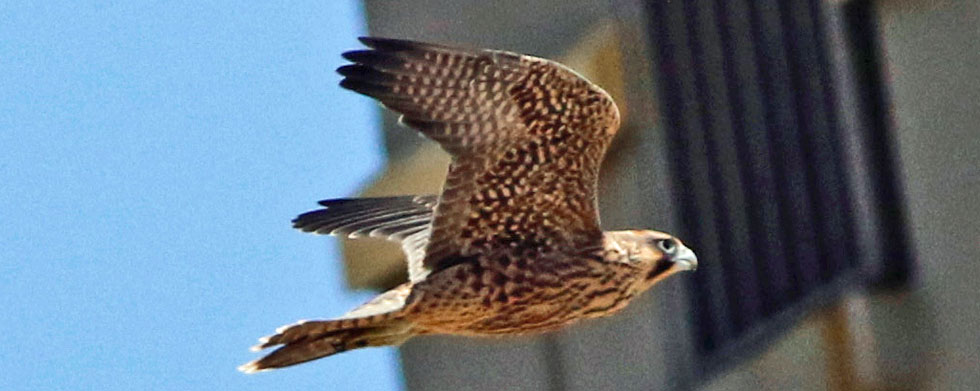 |
|
Two other examples of unusual nesting locales (or potential breeding sites) also highlighted June 2020. On 7 May, a single Western Kingbird was photographed on private land immediately adjacent to the public-access Rancho Cañada portion of Palo Corona Regional Park in lower Carmel Valley (Terence Degan). On 15 May, Carole & Larry Rose saw two kingbirds interacting as a pair at that spot; subsequent visits suggested the female was on eggs in a nest atop a heavy clump of pine cones about half-way up a dead Monterey Pine. By 18 June, they documented the presence of two chicks in the nest (photo below left, adult Western Kingbird flying up to nest on 18 June, © Carole Rose; adult feeding two begging nestling that same day, © Karen Kreiger).
This active nest of Western Kingbird with young is the first documented breeding this near the MTY coast in over a hundred years. The nest is in a group of standing dead pines not far from the northern bank of the Carmel River, and measures less than 4 km (<2.5 mi) from Carmel Bay. The bulk of the county population is in the Salinas Valley, starting at the Toro Park/eastern Ft. Ord vicinity and south and east throughout the lowland interior of MTY, reaching highest summer densities in oak savanna. There is a specimen from Monterey town itself from June 1892, and a presumed breeder from Carmel Valley collected on 28 June 1902, but generally Western Kingbirds do not breed within the summer fog zone of coastal and northwestern MTY. We have a few migrant Western Kingbirds along the coast in April-early May, and again in August-early September, but summer nests are a big surprise. |
|
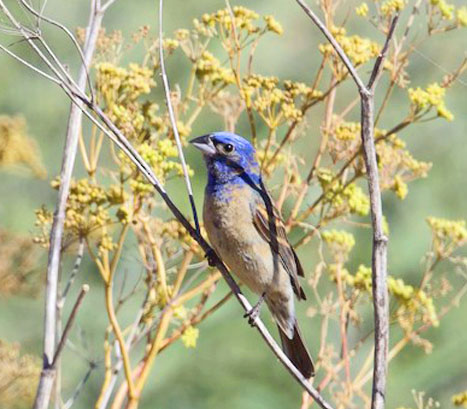 Less definitive as actual breeding, but nevertheless of local interest, was a singing male Blue Grosbeak in the eastern grasslands of Fort Ord National Monument, found by Terence Degan on 17 June (photo right, © T. Degan) and seen with a female on 19 June (C. & L. Rose); evidence of breeding included observations of the male carrying food. As you can see in the photo, this is a first-summer male with a blue head, rump, and tail, but has much brown still present in the back and upperwings, and is buffy (not yet blue) below. Less definitive as actual breeding, but nevertheless of local interest, was a singing male Blue Grosbeak in the eastern grasslands of Fort Ord National Monument, found by Terence Degan on 17 June (photo right, © T. Degan) and seen with a female on 19 June (C. & L. Rose); evidence of breeding included observations of the male carrying food. As you can see in the photo, this is a first-summer male with a blue head, rump, and tail, but has much brown still present in the back and upperwings, and is buffy (not yet blue) below.
The site this male has chosen for his territory is a scattered patchwork of fine Baccharis pilularis shrubs among dry grassland, but immediately downslope from a very large and dense patch of thistle and nettles, growing at a natural spring, that is used annually for a breeding colony of Tricolored Blackbirds. This year the entire colony was gone by mid-June — presumably all the adults and youngsters flew elsewhere once the juvs fledged — and the thistle edge is part of the grosbeak's territory. Still — the presence of two unrelated scarce and local breeding birds is notable.
The nearest breeding Blue Grosbeaks in MTY are in Baccharis patches near the Salinas River south of King City, where a few pairs were confirmed to breed annually during our 1988-1992 breeding bird atlas project, and thereafter through this year (see Roberson & Tenney, eds., Atlas of the Breeding Birds of Monterey County, 1993, for details of this discovery). Blue Grosbeaks also breed in Baccharis in dry grasslands just northeast of MTY, where the county borders of Santa Cruz, San Benito, and Santa Clara counties meet. But should this singing male on Fort Ord hook up with the female also seen there in June, and fledge young, it would be a dramatic expansion of its nesting range within MTY.
A singing male Blue Grosbeak was photographed at this exact same thistle patch on 1-2 May 2016, discovered during an Audubon Society field trip by Robert Horn, Virginia Chomat, Shawn Wagoner and others while they were watching the then-active Tricolored Blackbird colony. That Blue Grosbeak was a full adult male, so our 2020 male is a different bird. One wonders, however, if that 2016 male might have successfully bred, and whether this year's bird might be a descendant? |
|
Literature cited:
- Bausman, W.G. 2007. "California Gull" in Breeding Bird Atlas of Santa Clara County, California. Santa Clara Valley Audubon Society.
- Grinnell, J. 1902. Birds of the Little Sur River, Monterey County. Condor 6: 125–128,
- Roberson, D. 2002. Monterey Birds, 2d ed. Monterey Audubon Society, Carmel, CA.
- Roberson, D., S.F. Bailey, and R. Carratello. 2001. First successful United States nesting of Heermann's Gull: challenges of an urban colonist. North American Birds 55: 375-378.
- Roberson, D. 1993. "Hermit Thrush" in Atlas of the Breeding Birds of Monterey County, California (D. Roberson & C. Tenney, eds). Monterey Peninsula Audubon Society.
|
|
TOP
GO TO
HOME PAGE
TO MONTEREY
COUNTY
PAGE
TO BIRD
FAMILIES
OF THE WORLD
|


 Late May and early June is a period that can bring vagrant eastern birds to California. Each year is different —some years are better than others — there have been some springs that especially featured southeastern U.S. species. Spring 1992 was particularly memorable in California. Here in MTY we had 10 singing Northern Parulas, 4 singing Hooded Warblers, a singing Yellow-throated Warbler, and a singing Kentucky Warbler. Some opined in May that 2020 might be comparable; indeed, there was a singing Yellow-throated Warbler . . . but it was in Hollister, in San Benito Co., to our east (photo 19 May at Hollister, © Don Roberson).
Late May and early June is a period that can bring vagrant eastern birds to California. Each year is different —some years are better than others — there have been some springs that especially featured southeastern U.S. species. Spring 1992 was particularly memorable in California. Here in MTY we had 10 singing Northern Parulas, 4 singing Hooded Warblers, a singing Yellow-throated Warbler, and a singing Kentucky Warbler. Some opined in May that 2020 might be comparable; indeed, there was a singing Yellow-throated Warbler . . . but it was in Hollister, in San Benito Co., to our east (photo 19 May at Hollister, © Don Roberson). From mid-August into fall, MTY was devastated by three huge wildfires that together burned more than 240,000 acres in the center of the county. Each of the fires began between 16-18 August, and some of the merged: the 48,000 acre River Fire (photo © Crystal Hamer, left), the 69,000 acre Carmel Fire, and the 124,000 acre Dolan Fire in the Ventana Wilderness (it was contained but not yet out into December). Access to many areas was closed — sometimes for months — and the Ventana Wilderness Society lost its Condor release facilities. Three California Condors disappeared but a younster in a nest, thought also to have been lost, survived.
From mid-August into fall, MTY was devastated by three huge wildfires that together burned more than 240,000 acres in the center of the county. Each of the fires began between 16-18 August, and some of the merged: the 48,000 acre River Fire (photo © Crystal Hamer, left), the 69,000 acre Carmel Fire, and the 124,000 acre Dolan Fire in the Ventana Wilderness (it was contained but not yet out into December). Access to many areas was closed — sometimes for months — and the Ventana Wilderness Society lost its Condor release facilities. Three California Condors disappeared but a younster in a nest, thought also to have been lost, survived. 
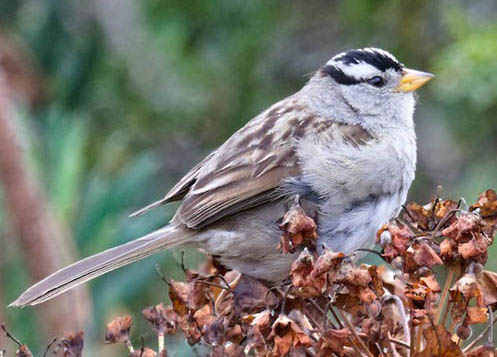


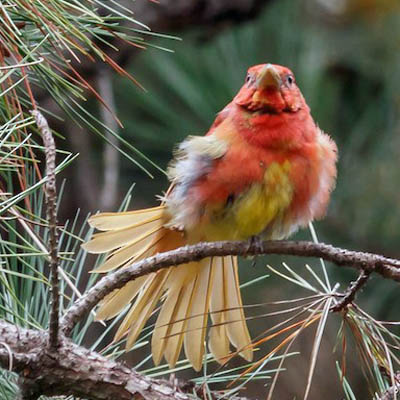
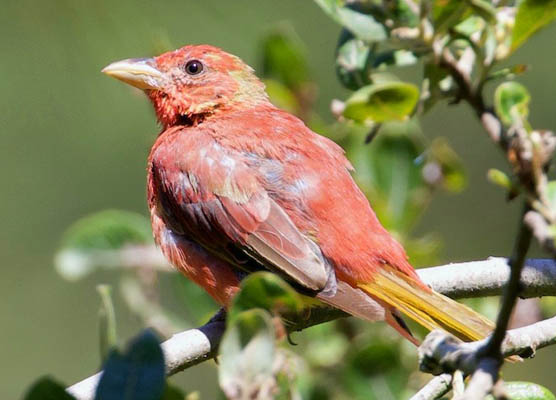






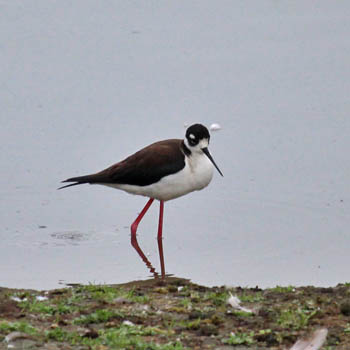
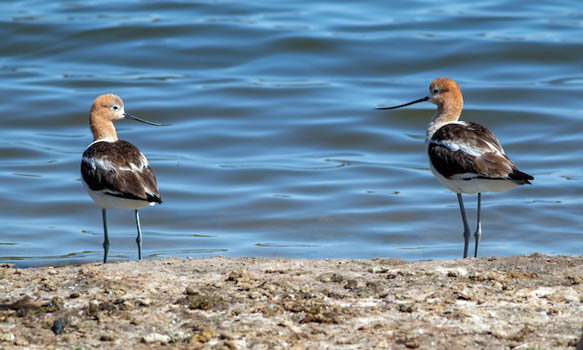
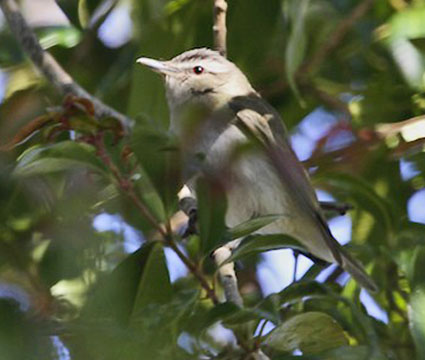
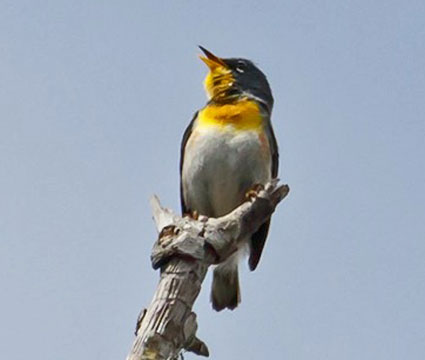
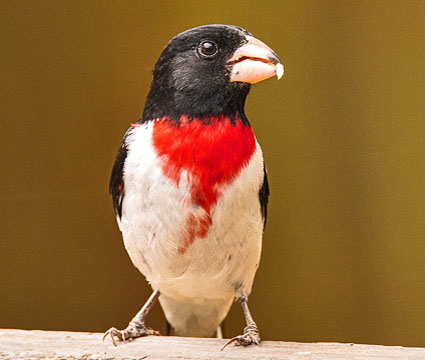
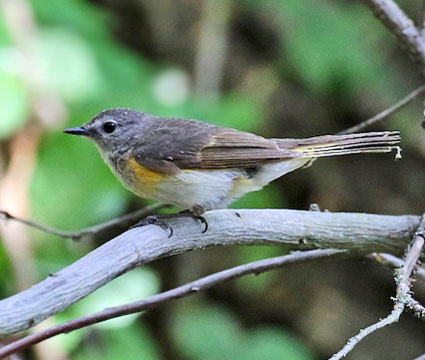

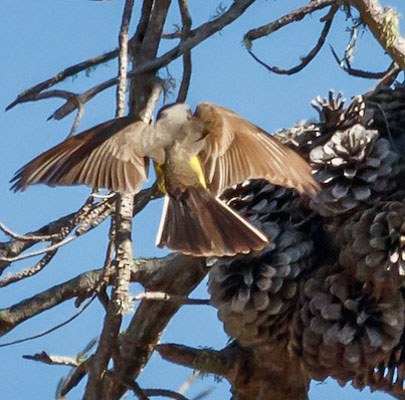
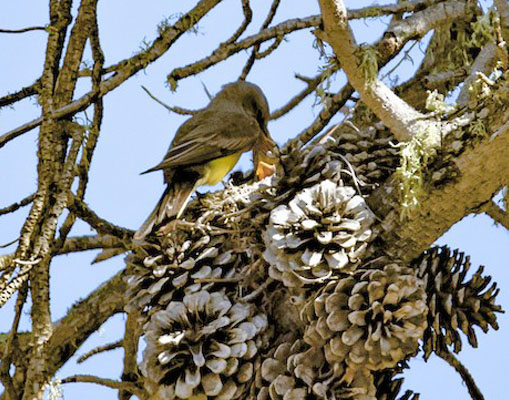
 Less definitive as actual breeding, but nevertheless of local interest, was a singing male Blue Grosbeak in the eastern grasslands of Fort Ord National Monument, found by Terence Degan on 17 June (photo right, © T. Degan) and seen with a female on 19 June (C. & L. Rose); evidence of breeding included observations of the male carrying food. As you can see in the photo, this is a first-summer male with a blue head, rump, and tail, but has much brown still present in the back and upperwings, and is buffy (not yet blue) below.
Less definitive as actual breeding, but nevertheless of local interest, was a singing male Blue Grosbeak in the eastern grasslands of Fort Ord National Monument, found by Terence Degan on 17 June (photo right, © T. Degan) and seen with a female on 19 June (C. & L. Rose); evidence of breeding included observations of the male carrying food. As you can see in the photo, this is a first-summer male with a blue head, rump, and tail, but has much brown still present in the back and upperwings, and is buffy (not yet blue) below.